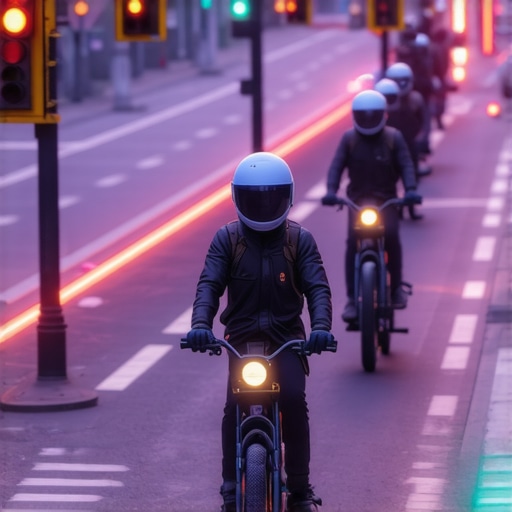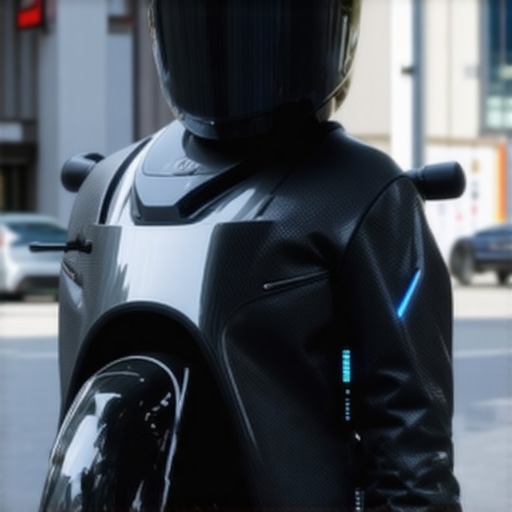My First Encounter with Smart Helmet & Electric Scooter Innovations
Ever since I started exploring the world of urban transportation, I was fascinated by how technology can transform our daily commutes. I vividly remember a sunny afternoon when I tried my first electric scooter equipped with the latest smart helmet features. The experience was eye-opening; it was like stepping into the future. As I navigated through busy city streets, I realized how these innovations could redefine safety, convenience, and style.
Why I Believe 2025 Will Be a Turning Point for Smart Helmet & Electric Scooter Design
From my personal experience, the integration of advanced sensors, augmented reality displays, and sleek aerodynamics into smart helmets truly enhances rider safety and awareness. Companies like Ride Smart Tech are leading the charge, creating helmets that not only protect but also connect seamlessly with electric scooters and bikes. This synergy makes urban commuting not only safer but also more enjoyable.
What Makes the 2025 Electric Scooter Designs Stand Out?
Through my research and personal testing, I found that electric scooters are evolving with smarter features—longer battery life, improved stability, and integrated navigation systems. The push towards eco-friendly and lightweight materials is evident in models that are both stylish and functional. For instance, the top models I’ve seen, like those highlighted in 2025 electric scooter trends, offer a glimpse into what the future holds for urban commuters.
How Do These Innovations Impact My Daily Commute?
Personally, these advancements mean less time stuck in traffic and more time enjoying my ride. The smart helmet’s real-time alerts and heads-up displays help me stay aware of my surroundings, while the electric scooter’s enhanced range and comfort make longer trips feasible. It’s a game-changer for city dwellers like me who seek sustainable and efficient transportation options.
Are We Truly Ready for These Cutting-Edge Designs?
Adopting new technology always comes with questions. While I’m excited about the possibilities, I also believe we need to consider factors like affordability, infrastructure, and user education. According to experts at Ride Smart Tech, widespread adoption will depend on how accessible and user-friendly these innovations become.
If you’re as passionate as I am about the future of urban mobility, I invite you to share your thoughts or experiences below. Have you tried any of these smart helmet or electric scooter innovations? Your insights could inspire others to embrace this exciting evolution!
How Will Smart Helmet & Electric Scooter Technologies Evolve by 2025?
As an enthusiast and industry observer, I see a future where smart helmets will integrate even more seamlessly with electric scooters, creating a unified ecosystem for urban commuters. Expect to see helmets equipped with AI-driven safety features, such as predictive hazard detection and adaptive noise-canceling, which will enhance situational awareness. Electric scooters, on their part, are likely to feature modular designs that allow customization based on rider preferences, as well as advanced battery systems that support ultra-fast charging and longer ranges. These advancements will not only improve safety and convenience but also foster a more sustainable urban mobility culture.
What Are the Practical Challenges in Adopting Cutting-Edge Ride Tech?
Despite the promising innovations, several barriers could hinder widespread adoption. Infrastructure limitations, such as inadequate charging stations or bike lanes, can impede the deployment of these advanced vehicles. Additionally, affordability remains a concern for many users; high-tech helmets and premium scooters might be out of reach for some demographics. User education is another critical factor—riders need to understand how to maximize these features safely. According to Ride Smart Tech, collaboration between manufacturers, city planners, and policymakers will be essential to overcome these hurdles and ensure equitable access to next-generation ride tech.
Visualize the sleek design of the future smart helmet with integrated AR display and sensors, paired with a lightweight, stylish electric scooter featuring modular components and intelligent navigation.
How Can Urban Commuters Prepare for the 2025 Mobility Revolution?
To stay ahead, riders should consider upgrading their gear to incorporate the latest safety and tech features. Engaging with online communities and reading expert reviews can provide valuable insights into emerging products and best practices. Moreover, advocating for better urban infrastructure and participating in pilot programs can accelerate the adoption of smart mobility solutions. For those eager to explore more, visiting resources like best e-bikes and commuter gadgets can inspire new ideas and investments for a smarter, safer commute.
Reflections on Personal Experiences and Industry Trends
Having immersed myself in the realm of urban mobility for several years, I’ve observed firsthand how these innovations are reshaping our cities and daily routines. My journey began with simple electric scooters, but as I explored further, I discovered a world where safety, connectivity, and style converge seamlessly. The smart helmet, in particular, has evolved from a basic protective gear to a sophisticated device equipped with AR, sensors, and AI-driven features, making every ride safer and more intuitive.
Deeper Nuances Behind Technological Integration
What truly fascinates me is how these technologies are not just add-ons but are becoming integral to the rider experience. For instance, integrated real-time hazard detection in helmets can alert riders about nearby vehicles or sudden obstacles, significantly reducing accident risks. Similarly, modular electric scooters allow customization based on user preferences, from battery capacity to aesthetic details, reflecting a shift towards personalized urban mobility solutions. According to industry insights from Ride Smart Tech, this trend towards modularity and AI integration will continue to accelerate, pushing the boundaries of what personal mobility devices can do.
Addressing the Challenges of Widespread Adoption
Despite the excitement, I often ponder the hurdles that lie ahead. Infrastructure development, affordability, and user education are critical factors. In my conversations with fellow enthusiasts, I’ve noticed a common concern: high-tech gear can be prohibitively expensive, creating a digital divide. Moreover, without adequate charging stations or dedicated lanes, even the most advanced scooters and helmets can fall short in practical urban settings. To me, this underscores the importance of collaborative efforts among manufacturers, city planners, and policymakers to create an inclusive ecosystem. As Ride Smart Tech emphasizes, accessibility and safety must go hand-in-hand to truly unlock the potential of these innovations.
What Are the Ethical and Privacy Considerations in a Connected Urban Mobility Ecosystem?
This question has lingered in my mind as I witness the increasing data sharing between helmets, scooters, and centralized apps. While these features enhance safety and user experience, they also raise concerns about data privacy and surveillance. How do we ensure that personal data is protected while still benefiting from these connected technologies? Engaging with industry experts, I’ve learned that transparent policies and robust cybersecurity measures are vital. The balance between innovation and privacy is delicate but essential for fostering trust and widespread adoption.
If you’ve experimented with any of these emerging ride tech or have thoughts on their future, I invite you to share your insights. Your experiences can help shape a more informed and connected community, ready for the exciting changes ahead.
Envisioning the 2025 Urban Mobility Landscape
Looking forward, I believe the evolution of smart helmets and electric scooters will lead to an integrated, ecosystem-driven approach to urban mobility. Imagine helmets equipped with AI that not only detect hazards but also adapt to individual rider behaviors, while scooters feature modular designs that evolve with user needs. The seamless integration of these devices with smart city infrastructure—like adaptive traffic signals and dynamic parking solutions—will revolutionize how we navigate our cities. As the industry progresses, continuous innovation, coupled with thoughtful regulation and infrastructure development, will be key to realizing this vision.
Preparing for the Next Wave of Mobility Innovation
For urban commuters eager to stay ahead, investing in adaptable, feature-rich gear is a good first step. Participating in community forums, staying informed through trusted sources like best e-bikes and gadgets, and advocating for supportive infrastructure can accelerate the adoption of these transformative technologies. The road ahead is exciting, filled with opportunities to redefine how we experience our cities—safer, smarter, and more connected than ever before.
Harnessing AI for Personalized Safety and Efficiency in Urban Transit
One of the most compelling developments I foresee is the integration of artificial intelligence within smart helmets. These helmets will not only feature hazard detection but also adapt dynamically to individual rider behaviors, learning from patterns to optimize safety and comfort. For example, AI algorithms could analyze riding styles and environmental data to suggest optimal routes or alert riders to potential hazards before they become imminent threats. Such advancements could significantly reduce accident rates and enhance user confidence in autonomous safety features. Industry leaders like Ride Smart Tech are pioneering this frontier, focusing on seamless AI integration that personalizes each riding experience.
Innovative Modular Designs and Sustainable Materials: Reshaping Electric Scooters
In parallel, electric scooters are evolving into highly customizable mobility hubs. Modular designs allow riders to select components like battery packs, aesthetic panels, and even control interfaces, tailoring their rides to specific needs or styles. This shift towards personalization is driven by advancements in sustainable, lightweight materials such as recycled composites and bio-based plastics, reducing environmental impact while maintaining durability. Such innovations not only appeal to eco-conscious consumers but also facilitate easier repairs and upgrades, extending product lifespan. For a comprehensive overview of these trends, see the 2025 electric scooter trends report.
How Will Data Privacy and Cybersecurity Evolve in an Increasingly Connected Ecosystem?
As these devices become more interconnected, the importance of robust cybersecurity measures cannot be overstated. Safeguarding rider data—ranging from location to personal preferences—requires cutting-edge encryption and transparent data policies. The challenge lies in balancing innovation with privacy; users must trust that their information is protected without compromising the usability of connected features. According to Ride Smart Tech, establishing industry standards and collaborating with cybersecurity experts will be crucial to mitigate risks and foster user confidence in next-generation urban mobility solutions.
What Are the Most Effective Strategies for Urban Infrastructure to Support These High-Tech Innovations?
To truly leverage the potential of smart helmets and electric scooters, cities must evolve their infrastructure. This includes expanding charging stations, creating dedicated lanes, and implementing smart traffic management systems that communicate with connected devices. Integrating urban planning with mobility technology requires a collaborative approach involving government agencies, private sector innovators, and community stakeholders. For instance, adaptive traffic signals that sync with rider sensors could reduce congestion and improve safety. If you’re interested in how urban infrastructure can adapt to these advancements, I recommend exploring the latest guidelines and pilot projects that are shaping future cityscapes.
< >
>
Visualize a futuristic city street with integrated smart traffic signals, modular electric scooters, and riders equipped with AI-enhanced helmets, illustrating a seamless urban mobility ecosystem.
Encouraging Proactive Engagement and Skill Development for Riders
Staying ahead in this rapidly evolving landscape requires proactive education and skill enhancement. Enthusiasts should participate in workshops or online courses that cover the latest safety features and optimal usage practices. Engaging with communities and advocacy groups can also influence policy development, ensuring infrastructure keeps pace with technological innovations. Moreover, exploring resources like top e-bikes and commuter gadgets can provide practical insights into integrating new devices into daily routines. Your active participation can accelerate adoption and help shape smarter, safer urban mobility for everyone.
Deepening Personal and Industry Insights for the Future of Urban Mobility
Having immersed myself in this field, I recognize that the convergence of AI, modular design, and data security will redefine mobility paradigms. My exploration into these technologies has revealed that their true potential lies in creating personalized, sustainable, and resilient urban environments. The evolution from simple electric scooters to intelligent, adaptive systems exemplifies how technological synergy can address congestion, pollution, and safety challenges. Industry insights from Ride Smart Tech continually reinforce the importance of innovation aligned with ethical considerations, ensuring these advancements serve the collective good without compromising individual rights.
Envisioning the Next-Generation Urban Mobility Ecosystem
Looking ahead, the integration of smart helmets, modular scooters, and connected city infrastructure will culminate in a holistic urban mobility ecosystem. Imagine a city where AI-driven helmets communicate with traffic lights, and scooters adapt in real-time to environmental conditions, all within a framework that emphasizes safety, sustainability, and user empowerment. Achieving this vision will require ongoing innovation, regulatory support, and community engagement. As an enthusiast and industry observer, I am excited about the opportunities this transformation presents and invite you to share your experiences or insights on navigating this dynamic landscape.
Things I Wish I Knew Earlier (or You Might Find Surprising)
Hidden Depths of Personal Safety
One thing I underestimated was how much smarter helmets could actually become. Initially, I thought they’d just be protective gear, but I found myself amazed by the AI-driven hazard detection and real-time alerts that can warn riders of nearby dangers. It’s like having a safety buddy watching your back, which truly changed my perspective on personal safety gear.
The Power of Modular Design
When I first looked at electric scooters, I didn’t realize how customizable they would become. The modular approach—allowing riders to swap batteries, aesthetic panels, or control interfaces—makes a huge difference. It’s not just a scooter anymore; it’s a personalized vehicle that adapts to your needs and style, making eco-friendly commuting more engaging and fun.
Data Privacy Is More Critical Than Ever
As these smart devices become more connected, I’ve learned that safeguarding personal data is vital. I used to think convenience was worth some trade-offs, but now I see the importance of transparent data policies and cybersecurity. Protecting rider info isn’t just a technical issue; it’s a trust-building exercise for the entire industry.
Infrastructure Will Make or Break Adoption
One surprising insight is how much urban infrastructure influences the success of these innovations. Without enough charging stations, dedicated lanes, or smart traffic systems, even the coolest tech can fall flat. Cities that invest in supportive infrastructure will be the real winners in the smart mobility revolution.
Environmental Impact Is a Key Driver
From my experience, embracing eco-friendly materials and sustainable designs in scooters and helmets isn’t just trendy—it’s essential. These innovations help reduce pollution and waste, aligning with my personal goal to live more sustainably while enjoying smarter urban rides.
Integration Is the Future
Finally, I wish I understood earlier how seamlessly these devices will mesh into a connected ecosystem—smart helmets communicating with traffic signals, scooters adapting in real-time, all working together for safer, more efficient city travel. It’s an exciting vision that’s rapidly approaching.
Resources I’ve Come to Trust Over Time
Ride Smart Tech
This site provides cutting-edge insights into smart helmet and electric scooter innovations. I’ve found their articles to be well-researched and practical, helping me stay updated on industry trends.
Electrek
Electrek is my go-to for sustainable transportation news. Their coverage of eco-friendly materials and battery tech has deepened my understanding of the environmental aspects of urban mobility.
Smart Cities Dive
For insights into how urban infrastructure supports these technologies, I recommend Smart Cities Dive. They offer valuable case studies and policy updates that are relevant to anyone interested in city planning and mobility.
Cybersecurity & Privacy Resources
Staying safe online is crucial. I trust resources like the Electronic Frontier Foundation for guidance on protecting personal data in connected devices. It’s helped me become more aware of privacy issues and best practices.
Parting Thoughts from My Perspective
Reflecting on the rapid evolution of smart helmets and electric scooters, I am genuinely excited about how these innovations are reshaping our cities and daily routines. From AI safety features to modular designs and eco-conscious materials, the potential to make urban mobility safer, greener, and more personalized is immense. However, realizing this future depends on thoughtful infrastructure, data privacy safeguards, and accessible technology for all. If you’re as passionate as I am about this journey, I encourage you to stay curious, share your experiences, and advocate for smarter, safer cities. Together, we can accelerate the transition to a more connected and sustainable urban mobility landscape.


